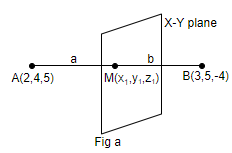
A = (2, 4, 5) and B = (3, 5, -4) are two points. If the XY-plane, YZ-plane divide AB in the ratio a : b and p : q respectively, then $\dfrac{a}{b}+\dfrac{p}{q}=$
A. $\dfrac{23}{12}$
B. $\dfrac{-7}{12}$
C. $\dfrac{7}{12}$
D. $\dfrac{-22}{15}$
Answer
574.2k+ views
Hint: The line AB is divided internally by XY-plane and YZ-plane. So, we will use the section formula internally to solve this question, that is $\left( \dfrac{m{{x}_{2}}+n{{x}_{1}}}{m+n},\dfrac{m{{y}_{2}}+n{{y}_{1}}}{m+n},\dfrac{m{{z}_{2}}+n{{z}_{1}}}{m+n} \right)$. The z coordinate of the XY-plane is zero and the x coordinate of the YZ-plane is zero.
Complete step by step answer:
We will understand this question by first drawing the figure for the XY-plane as given below.

We can see in the above figure that $M\left( {{x}_{1}},{{y}_{1}},{{z}_{1}} \right)$ is a point on XY-plane such that AB is divided internally by XY-plane in the ratio of a : b. So, we will now use the section formula internally to find the coordinate of M. We know that the section formula (internally) is given by the formula, $\left( \dfrac{m{{x}_{2}}+n{{x}_{1}}}{m+n},\dfrac{m{{y}_{2}}+n{{y}_{1}}}{m+n},\dfrac{m{{z}_{2}}+n{{z}_{1}}}{m+n} \right)$. So, applying this, we have the coordinates of $M\left( {{x}_{1}},{{y}_{1}},{{z}_{1}} \right)$as,
$=\left( \dfrac{3a+2b}{a+b},\dfrac{5a+4b}{a+b},\dfrac{-4a+5b}{a+b} \right)$
As we know that the z coordinate of XY-plane is equal to 0, therefore, we have,
$\begin{align}
& {{z}_{1}}=0 \\
& \Rightarrow \dfrac{-4a+5b}{a+b}=0 \\
& \Rightarrow -4a+5b=0\times \left( a+b \right) \\
& \Rightarrow -4a+5b=0 \\
& \Rightarrow 4a=5b \\
& \Rightarrow \dfrac{a}{b}=\dfrac{5}{4} \\
\end{align}$
Now, we will draw the figure for the YZ-plane.

We can see form the above figure that $N\left( {{x}_{2}},{{y}_{2}},{{z}_{2}} \right)$ is a point on YZ-plane such that AB is divided internally by YZ-plane in the ratio of p : q. Now, we will again use the section formula internally to find the coordinate of N. So, applying the section formula (internally), we will have the coordinate of $N\left( {{x}_{2}},{{y}_{2}},{{z}_{2}} \right)$ as,
$=\left( \dfrac{3p+2q}{p+q},\dfrac{5p+4q}{p+q},\dfrac{-4p+5q}{p+q} \right)$
Now, we know that the x coordinate of YZ plane is equal to 0, therefore, we get,
$\begin{align}
& {{x}_{2}}=0 \\
& \Rightarrow \dfrac{3p+2q}{p+q}=0 \\
& \Rightarrow 3p+2q=0\left( p+q \right) \\
& \Rightarrow 3p+2q=0 \\
& \Rightarrow 3p=-2q \\
& \Rightarrow \dfrac{p}{q}=\dfrac{-2}{3} \\
\end{align}$
We have obtained $\dfrac{a}{b}=\dfrac{5}{4}$ and $\dfrac{p}{q}=\dfrac{-2}{3}$, we can find $\dfrac{a}{b}+\dfrac{p}{q}$. So, solving it we get,
$\dfrac{5}{4}+\left( \dfrac{-2}{3} \right)\Rightarrow \dfrac{5}{4}-\dfrac{2}{3}\Rightarrow \dfrac{15-8}{12}=\dfrac{7}{12}$
Thus, we get the value as, $\dfrac{a}{b}+\dfrac{p}{q}=\dfrac{7}{12}$.
So, the correct answer is “Option C”.
Note: The students must remember that when a point lies somewhere between the two points, the line segment is divided internally. And when a point lies on the external part of the segment, that is when you extend the segment, then its actual length, the point lies there, then the line segment is divided externally. We have to use the section formulas for internal division as, $\left( \dfrac{m{{x}_{2}}+n{{x}_{1}}}{m+n},\dfrac{m{{y}_{2}}+n{{y}_{1}}}{m+n} \right)$ and for external division as, $\left( \dfrac{m{{x}_{2}}-n{{x}_{1}}}{m-n},\dfrac{m{{y}_{2}}-n{{y}_{1}}}{m-n} \right)$.
Complete step by step answer:
We will understand this question by first drawing the figure for the XY-plane as given below.

We can see in the above figure that $M\left( {{x}_{1}},{{y}_{1}},{{z}_{1}} \right)$ is a point on XY-plane such that AB is divided internally by XY-plane in the ratio of a : b. So, we will now use the section formula internally to find the coordinate of M. We know that the section formula (internally) is given by the formula, $\left( \dfrac{m{{x}_{2}}+n{{x}_{1}}}{m+n},\dfrac{m{{y}_{2}}+n{{y}_{1}}}{m+n},\dfrac{m{{z}_{2}}+n{{z}_{1}}}{m+n} \right)$. So, applying this, we have the coordinates of $M\left( {{x}_{1}},{{y}_{1}},{{z}_{1}} \right)$as,
$=\left( \dfrac{3a+2b}{a+b},\dfrac{5a+4b}{a+b},\dfrac{-4a+5b}{a+b} \right)$
As we know that the z coordinate of XY-plane is equal to 0, therefore, we have,
$\begin{align}
& {{z}_{1}}=0 \\
& \Rightarrow \dfrac{-4a+5b}{a+b}=0 \\
& \Rightarrow -4a+5b=0\times \left( a+b \right) \\
& \Rightarrow -4a+5b=0 \\
& \Rightarrow 4a=5b \\
& \Rightarrow \dfrac{a}{b}=\dfrac{5}{4} \\
\end{align}$
Now, we will draw the figure for the YZ-plane.

We can see form the above figure that $N\left( {{x}_{2}},{{y}_{2}},{{z}_{2}} \right)$ is a point on YZ-plane such that AB is divided internally by YZ-plane in the ratio of p : q. Now, we will again use the section formula internally to find the coordinate of N. So, applying the section formula (internally), we will have the coordinate of $N\left( {{x}_{2}},{{y}_{2}},{{z}_{2}} \right)$ as,
$=\left( \dfrac{3p+2q}{p+q},\dfrac{5p+4q}{p+q},\dfrac{-4p+5q}{p+q} \right)$
Now, we know that the x coordinate of YZ plane is equal to 0, therefore, we get,
$\begin{align}
& {{x}_{2}}=0 \\
& \Rightarrow \dfrac{3p+2q}{p+q}=0 \\
& \Rightarrow 3p+2q=0\left( p+q \right) \\
& \Rightarrow 3p+2q=0 \\
& \Rightarrow 3p=-2q \\
& \Rightarrow \dfrac{p}{q}=\dfrac{-2}{3} \\
\end{align}$
We have obtained $\dfrac{a}{b}=\dfrac{5}{4}$ and $\dfrac{p}{q}=\dfrac{-2}{3}$, we can find $\dfrac{a}{b}+\dfrac{p}{q}$. So, solving it we get,
$\dfrac{5}{4}+\left( \dfrac{-2}{3} \right)\Rightarrow \dfrac{5}{4}-\dfrac{2}{3}\Rightarrow \dfrac{15-8}{12}=\dfrac{7}{12}$
Thus, we get the value as, $\dfrac{a}{b}+\dfrac{p}{q}=\dfrac{7}{12}$.
So, the correct answer is “Option C”.
Note: The students must remember that when a point lies somewhere between the two points, the line segment is divided internally. And when a point lies on the external part of the segment, that is when you extend the segment, then its actual length, the point lies there, then the line segment is divided externally. We have to use the section formulas for internal division as, $\left( \dfrac{m{{x}_{2}}+n{{x}_{1}}}{m+n},\dfrac{m{{y}_{2}}+n{{y}_{1}}}{m+n} \right)$ and for external division as, $\left( \dfrac{m{{x}_{2}}-n{{x}_{1}}}{m-n},\dfrac{m{{y}_{2}}-n{{y}_{1}}}{m-n} \right)$.
Recently Updated Pages
Master Class 12 Business Studies: Engaging Questions & Answers for Success

Master Class 12 Economics: Engaging Questions & Answers for Success

Master Class 12 English: Engaging Questions & Answers for Success

Master Class 12 Maths: Engaging Questions & Answers for Success

Master Class 12 Social Science: Engaging Questions & Answers for Success

Master Class 12 Chemistry: Engaging Questions & Answers for Success

Trending doubts
What are the major means of transport Explain each class 12 social science CBSE

Which are the Top 10 Largest Countries of the World?

Draw a labelled sketch of the human eye class 12 physics CBSE

How much time does it take to bleed after eating p class 12 biology CBSE

Explain sex determination in humans with line diag class 12 biology CBSE

Differentiate between homogeneous and heterogeneous class 12 chemistry CBSE




